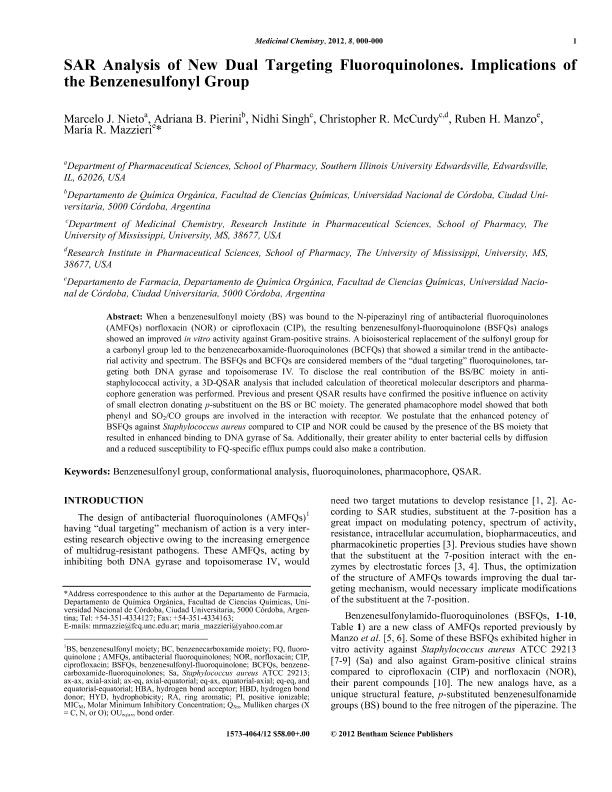Mostrar el registro sencillo del ítem
dc.contributor.author
Nieto, Marcelo J.
dc.contributor.author
Pierini, Adriana Beatriz

dc.contributor.author
Singh, Nidhi
dc.contributor.author
McCurdy, Christopher R.
dc.contributor.author
Manzo, Ruben Hilario

dc.contributor.author
Mazzierie, María
dc.date.available
2020-09-18T20:19:01Z
dc.date.issued
2012-05
dc.identifier.citation
Nieto, Marcelo J.; Pierini, Adriana Beatriz; Singh, Nidhi; McCurdy, Christopher R.; Manzo, Ruben Hilario; et al.; SAR analysis of new dual targeting fluoroquinolones. Implications of the benzenesulfonyl group; Bentham Science Publishers; Medicinal Chemistry; 8; 3; 5-2012; 349-360
dc.identifier.issn
1573-4064
dc.identifier.uri
http://hdl.handle.net/11336/114352
dc.description.abstract
When a benzenesulfonyl moiety (BS) was bound to the N-piperazinyl ring of antibacterial fluoroquinolones (AMFQs) norfloxacin (NOR) or ciprofloxacin (CIP), the resulting benzenesulfonyl-fluoroquinolone (BSFQs) analogs showed an improved in vitro activity against Gram-positive strains. A bioisosterical replacement of the sulfonyl group for a carbonyl group led to the benzenecarboxamide-fluoroquinolones (BCFQs) that showed a similar trend in the antibacterial activity and spectrum. The BSFQs and BCFQs are considered members of the "dual targeting" fluoroquinolones, targeting both DNA gyrase and topoisomerase IV. To disclose the real contribution of the BS/BC moiety in antistaphylococcal activity, a 3D-QSAR analysis that included calculation of theoretical molecular descriptors and pharmacophore generation was performed. Previous and present QSAR results have confirmed the positive influence on activity of small electron donating p-substituent on the BS or BC moiety. The generated phamacophore model showed that both phenyl and SO2/CO groups are involved in the interaction with receptor. We postulate that the enhanced potency of BSFQs against Staphylococcus aureus compared to CIP and NOR could be caused by the presence of the BS moiety that resulted in enhanced binding to DNA gyrase of Sa. Additionally, their greater ability to enter bacterial cells by diffusion and a reduced susceptibility to FQ-specific efflux pumps could also make a contribution.
dc.format
application/pdf
dc.language.iso
eng
dc.publisher
Bentham Science Publishers

dc.rights
info:eu-repo/semantics/openAccess
dc.rights.uri
https://creativecommons.org/licenses/by-nc-sa/2.5/ar/
dc.subject
BENZENESULFONYL GROUP
dc.subject
CONFORMATIONAL ANALYSIS
dc.subject
FLUOROQUINOLONES
dc.subject
PHARMACOPHORE
dc.subject
QSAR
dc.subject.classification
Química Orgánica

dc.subject.classification
Ciencias Químicas

dc.subject.classification
CIENCIAS NATURALES Y EXACTAS

dc.title
SAR analysis of new dual targeting fluoroquinolones. Implications of the benzenesulfonyl group
dc.type
info:eu-repo/semantics/article
dc.type
info:ar-repo/semantics/artículo
dc.type
info:eu-repo/semantics/publishedVersion
dc.date.updated
2018-09-18T16:23:11Z
dc.identifier.eissn
1875-6638
dc.journal.volume
8
dc.journal.number
3
dc.journal.pagination
349-360
dc.journal.pais
Estados Unidos

dc.journal.ciudad
Oak Park
dc.description.fil
Fil: Nieto, Marcelo J.. Southern Illinois University al Edwardsville; Estados Unidos
dc.description.fil
Fil: Pierini, Adriana Beatriz. Consejo Nacional de Investigaciones Científicas y Técnicas. Centro Científico Tecnológico Conicet - Córdoba. Instituto de Investigaciones en Físico-química de Córdoba. Universidad Nacional de Córdoba. Facultad de Ciencias Químicas. Instituto de Investigaciones en Físico-química de Córdoba; Argentina
dc.description.fil
Fil: Singh, Nidhi. Mississippi State University.; Estados Unidos
dc.description.fil
Fil: McCurdy, Christopher R.. Mississippi State University.; Estados Unidos
dc.description.fil
Fil: Manzo, Ruben Hilario. Consejo Nacional de Investigaciones Científicas y Técnicas; Argentina. Universidad Nacional de Córdoba. Facultad de Ciencias Químicas. Departamento de Farmacia; Argentina
dc.description.fil
Fil: Mazzierie, María. Universidad Nacional de Córdoba. Facultad de Ciencias Químicas. Departamento de Farmacia; Argentina
dc.journal.title
Medicinal Chemistry

dc.relation.alternativeid
info:eu-repo/semantics/altIdentifier/doi/http://dx.doi.org/10.2174/157340612800786633
dc.relation.alternativeid
info:eu-repo/semantics/altIdentifier/url/https://www.eurekaselect.com/98945/article
Archivos asociados
